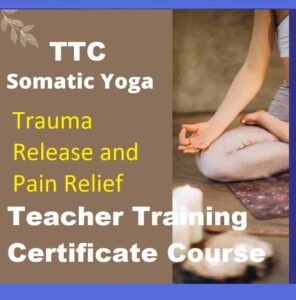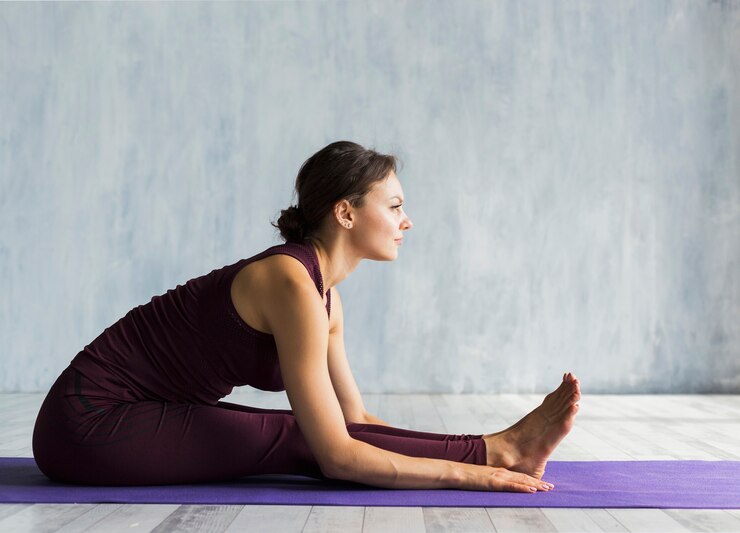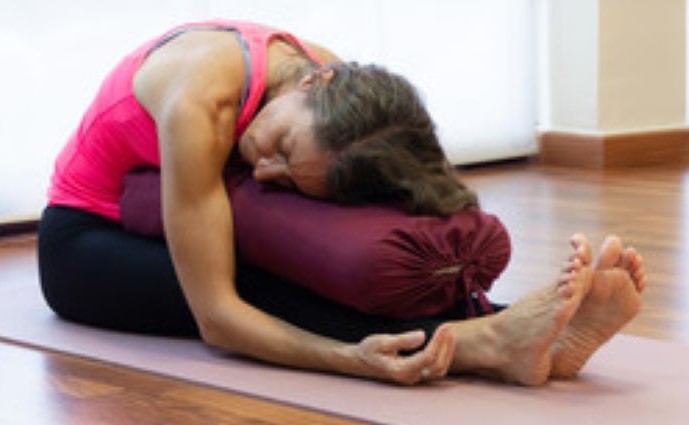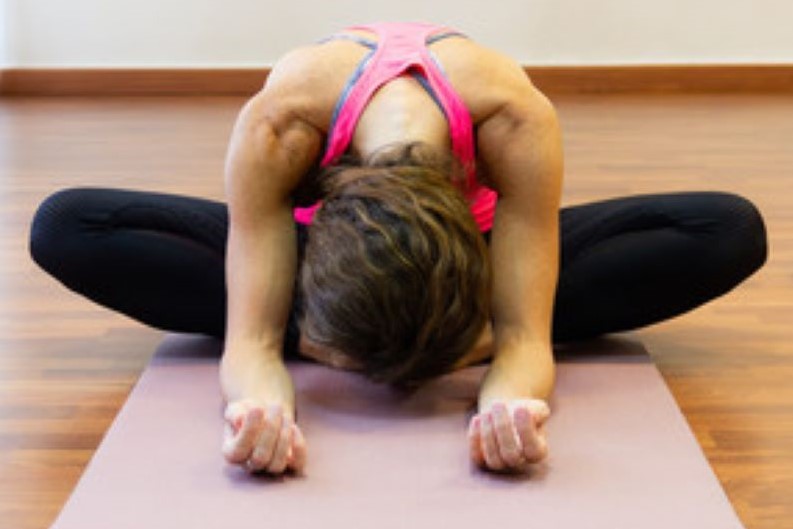100 Hrs Somatic & Yin Yoga Teacher Training Certificate Course, Bangalore, India.
- Contact Hours: 50 Hours
Contact Hr – Direct or live interaction with Teacher. This includes in-person or real-time online sessions where you are actively engaged with the teacher, receiving instruction, feedback, and guidance.
Non-Contact Hr – Reading a book or article, or watching a video, Self-Practice, Written Assignment, Project Work, Audio Assignment, Video Assignment.
- Non-Contact Hours 50 Hours
- Course: 100 Hrs Somatic & Yin Yoga Teacher Training Certificate Course
- Total Fee for the Training(For Indian Citizens Only): INR 15,000(Registration Fee) + INR 35,000 (Course Fee) = INR 50,000
- Total Fee for the Training(For Non-Indian Citizens Only): USD 270(Registration Fee) + USD 400 (Course Fee) = USD 670
- Accreditation: Yoga Alliance USA YACEP.
- Skill level: Beginners, Intermediate & Advanced
- Self-Paced/ Flexible Duration: Online or Regular Mode.
- Language: English
- Mode: Offline/Online/Hybrid/Self-Paced
- About the course facilitator: Dr. S. Karuna Murthy, M.Sc., Ph.D., E-RYT 500, YACEP
- Language: Our courses will be held in English Medium.
- Course Dates: Please Contact Us (karunaayoga@gmail.comor +91 9686549129)
Our 100 hours Yoga Teachers Training Course Yin Yoga Teacher Training Course is beautifully programmed for those enthusiasts who desire to have a professional certificate in the future but can’t afford the time of two months in one slot.
If you have less time or you want to learn slowly, so 100-hour yoga teacher training course in Bangalore can be the perfect yoga course for you, karuna yoga offers a self-paced yoga teacher training course in Bangalore India, and you can join the other half in 1 year of time to complete 200/300 hours Teacher Training Course.
In order to obtain a professional certificate of 200/300 Hour, Teachers Training Course affiliated with Yoga alliance one has to complete the 200 Hours which is usually completed in one or two months of time, we designed this course in such a way that if any participant wants to first get introduced with the way and process of professional yoga teacher training course and have only short time then students can enroll for this yoga course.
Our 100 hours Yoga Teacher Training Course program runs along with our regular student of 200/300-hour Teacher Training Course students in the first phase, upon completion of the course if a student wants to finish remaining their balance of 100/200 hours of Teacher Training Course in the future, then students can continue the course of the second stage of Teacher Training Course to obtain 200/300-hour Teacher Training Course certificate affiliated with Yoga Alliance in order to have a professional certificate.
Our 100 hours can be accepted as continuing education from Yoga Alliance if in the future you want to continue the training from our center. Please make a note while completing 100 hour TTC you will be only provided with a certificate issued by our organization and the certificate will not be affiliated with Yoga Alliance, and only after completion of the second stage of balance 100/200 hours of TTC, which technically becomes 200/300 hours in total of training, we will issue the certificate of 200/300-hour Teacher Training Course.
Karuna Yoga Vidya Peetham is a Registered Yoga teacher training school in Bangalore, India with an affiliation of Yoga Alliance, USA which offers 50 Hour Yoga Teacher Training in Bangalore, India. If you look forward to the course then this is the best choice.
Yoga Continuing Education Courses (YACEP)
We offer various training programs to deepen knowledge and improve teaching skills through various yoga teacher training courses.
Yoga Alliance Registered Continuing Education Provider, Courses Open to Everyone.
This course is eligible for Continued Education (CE) credits with Yoga Alliance. It is accredited by Yoga Alliance and it can be used as a continuing education course (YACEP) for Register Yoga Teachers with Yoga Alliance
Deepen your practice and your knowledge
Are you are a yoga professional or a curious practitioner and wish to deepen your yoga knowledge and techniques? Then a continuing education course may be something for you! You will learn selected specialized yoga topics that will allow you to expand your horizons when it comes to your personal practice or that of your students. With the knowledge you will acquire, you will gain a deeper understanding of the functioning of anatomical and energetic body layers, and develop a more complete insight into yoga.
Pre-requisites:
This course is open to all students who wish to deepen their knowledge and application of some of the highest teachings.
Participants do not need to be yoga Mastery of any yoga practice is not
Only yours sincere desire for knowledge and your commitment to personal
Love for Yoga is the most important eligibility factor for learning this course.
Students who want to know Yoga in totality and move beyond Asana and Pranayama, Mudra & Bandha.
What you’ll learn
You will learn beginners level asana, forward, backward, arm balance, hip opening and inverted poses.
You will know the how to Integrate asana, pranayama mudra sutra into your yoga practice.
You will learn the methods given by Swatmarama to mastery your mind through hatha yoga.
Practice asana, pranayama and Savasana daily
Improve your practice of advanced asanas daily
Get more insights into the core principles of yogic philosophy
Deepen your understanding and application of mudras and bandhas.
Assessment and Certification
The students are continuously assessed throughout the course at all levels. There will be a written exam at the end of the course to evaluate the understanding of the philosophy of Yoga and skills of the students. Participants should pass all different aspects of the course to be eligible for the course diploma.
Recommended TextsAsana Pranayama Mudra Bandha by Swami Niranjananda Saraswati
B. K.S. Iyengar, Light On Yoga.
Terms & Conditions:
After the payment of the course fee, you will receive a link to access the classes through Zoom. This short term course is only meant for sincere students of Yoga practitioner. Without submitting the required assignments, you will not receive a certification. Please note that the course fee is non refundable. However, if you can’t start the course due to severe circumstances, please get in touch with us and we’ll find a solution for you.
Curriculum – 100 Hr – Somatic & Yin Yoga Teacher Training Course
Chapter – 1
1. Introduction
1.1. What is Yin Yoga?
1.2. What is Yang Yoga?
1.3. Yin & Yang Tissues
1.4. Yin & Yang Yoga
Chapter – 2
1. History of Yin Yoga
1.1. Yin and Yang
1.2. Daoism or sushumna nadi
1.3. Yin Contains Yang
1.4. Yin Becomes Yang
1.5. Yin Controls Yang
2. Daoist Yoga
2.1. The Dao is the balance between the two.
3. The Three Tattvas of Yin Yoga Practice
3.1. Playing Our Edges
3.2. We don’t use our body to get into a pose,
3.3. Resolving To Be Still
3.4. Stillness of the Body
3.5. Stillness of the Breath
3.6. Stillness of the Mind
3.7. Holding for Time
3.8. How Deep?
3.9. How Long?
3.10. How Often?
Chapter – 3
1. Yin and Yang Compared
2. Physiology
Chapter – 4
1. Differences between Yin and Restorative Yoga Props
1.1. Poses
1.2. Stretch
Chapter – 5
1. Elasticity and plasticity
1.1. Elasticity: Fascial Conditioning
1.2. Plasticity: Fascial Stretching
1.3. Plastic Versus Elastic
1.4. Fascial Growth and Yoga
Chapter – 6
1. Tension and Compression
1.1. Tension
1.2. Compression
1.3. When the restriction is tension:
1.4. When the restriction is compression:
1.5. Why it is important to know when you hit compression.
1.6. How to recognize whether the restriction you feel in your body is because of tension or compression?
1.7. The humerus and acromion process
Chapter – 7
1. Yin Yoga Contraindications
Chapter – 8
1. General Guidelines
Chapter – 9
9. Structure of Yin Yoga Class
9.1. Intention and Attention
9.2. Beginning the Practice
9.3. Intention
9.4. Invocation
9.5. Opening Meditation
9.6. Flowing
9.7. Beginning Asanas
9.8. The Ocean Breath
9.9. Linking Asanas
9.10. Finishing Asanas
9.11. Ending the Practice
9.12. Shavasana
9.13. Closing Meditation
9.14. Transition to Your Next Activity
Chapter – 10
1. Benefits of Yin Yoga
Chapter – 11
1. Benefits of yin yoga
1.1. Yin Yoga and the Joints
1. Prevent Contracture
2. Prevent Degeneration
3. Reduce Fixation
4. Provide Hydration
Chapter – 12
1. Tissues in the human body
1.1. Connective Tissues
1.2. Ligaments and Tendons
1.3. Yin Yoga & Joints
1.4. The Spine
1.5. Spinal Movement
Chapter – 13
1. Tissues and Their Flexibility
2. Limits of Flexibility
Chapter – 14
1. When to Practice Yin Yoga
Chapter – 16
1. Types of Joints
Chapter – 16
1. Synovial Joints
1.1. The Joint Capsule
Chapter – 17
1. Bones and Cartilage
Chapter – 18
1. Muscle Tissue
1.2. The Make-up of Muscles
Chapter – 19
1. Collagen
Chapter – 20
1. Collagen in the Bones
1.1. Directional stress on connective tissues
Chapter – 21
1. Fascia
Chapter – 22
1. Connective Tissues (CT)
•Bone
•Blood
•Cartilage
Chapter – 23
1. Tendons and Ligaments
1.1. Ligaments
Chapter – 24
1. Muscle Tissue is Yang, Connective Tissue is Yin
1.1. Yang Yoga Focuses on Muscle
1.2. Yin Yoga Focuses on Connective Tissue
1.3. Yin and Yang Supplement Each Other
1.4. Three Layers of a Joint
1.5. Breathing
1.6. Exercise in Awareness
1.7. Learning to Relax
1.8. Learning to be Still
Chapter – 25
25. The Asanas
This selection will suffice to work all the areas of the body normally targeted in a Yin Yoga practice:
1. Anahatasana (aka Melting Heart)
2. Ankle Stretch
3. Bananasana
4. Butterfly
5. Half Butterfly
6. Camel
7. Cat pulling Its Tail
8. Caterpillar
9. Child’s Pose
10. Dangling
11. Deer
12. Dragons
13. Frog
14. Happy Baby
15. Reclining Twist
16. Saddle
17. Shavasana
18. Shoelace
19. Snail
20. Sphinx and seal
21. Square
22. Squat
23. Straddle (aka Dragonfly)
24. Swan & Sleeping Swan
25. Toe Squat
26. Yin Postures for the Upper Body
Somatic Yoga Training Syllabus
Module:1 Techniques Training And Practice
Breaking down core concepts & progressive skill building
Basic Somatic movements
Embodying natural and intuitive movements
How to move slowly, gently and with awareness
Safe & effective forward, backbends, lateral and twisting poses
The power and importance of moving from the centre of the body
Flowing transitions between poses & linking breath to movement
Circulation through the blood flow
Mindfulness in action and no mind movements
Both dynamic and still meditation
Kriyas, yogic cleansing techniques and pranayama
The art of effectively releasing tensions
Module: 2 Teaching Methodology
The importance of sensing yourself before and after a practice
Purposeful touch
The language of movement
Voice projection, how to use your voice as a tool in class
Rhythm and pacing
Class planning , for groups, privates and workshops
Intelligent, efficient and creative sequencing for yoga
Conscious communication skills
Facilitating deep relaxation
Module:3 Anatomy And Physiology
Somatic inquiry and movement
The three reflexes, and sensory motor amnesia
Pandiculation and basic neurology
Body assessment
Why we suffer from chronical pain and long term solutions
Applied anatomy and physiology
The anatomy of the breath
How to create muscular stability around the joint complexes
How to reset the nervous system deeply and stimulate the relaxation reflex
Module:4 Yoga Philosophy, Lifestyle, Ethics
Establishing routine and self-practice
The meaning of Soma, the somatic perspective and characteristics
Philosophy and Yoga sutras applied to modern life
The teachings of the Buddha
Sanskrit names of the poses
The koshas, gunas and 5 elements
Exploring E(motion) and the psychology of yoga
How to navigate the process of transformation
Understanding the relation between control and freedom and how they are linked
How to keep your passion alive and transmit it
The business side of teaching
Embodying the practice and philosophy of yoga in daily life
Healthy diet and nutrition
Meditation
Module:5 Practicum
Partner work, and small group teaching
Elaborate your own yoga sequence
Create a somatic yoga movement class
Observing each other teach , and giving, receiving feedback
Building confidence and trust
Empowerment to find your authentic voice
The importance of your own practice when you are teaching
How to apply what you learn from your practice to your everyday life.
